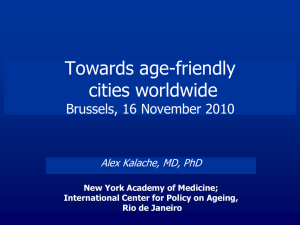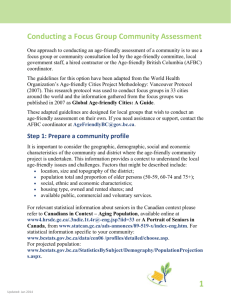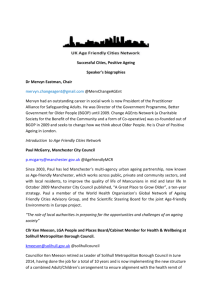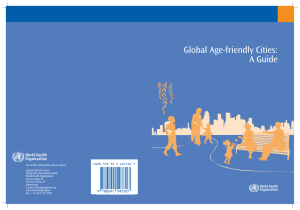Professor Chris Phillipson, Manchester University
advertisement
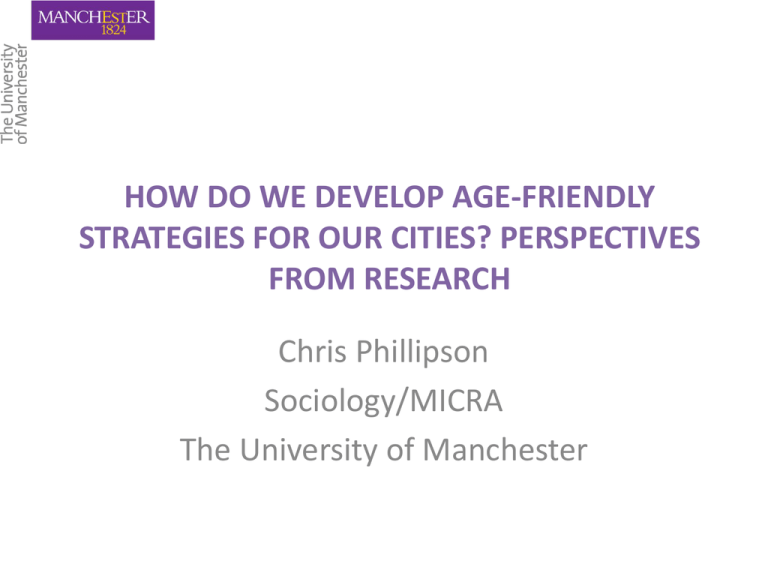
HOW DO WE DEVELOP AGE-FRIENDLY STRATEGIES FOR OUR CITIES? PERSPECTIVES FROM RESEARCH Chris Phillipson Sociology/MICRA The University of Manchester AREAS FOR DISCUSSION • CONTEXT FOR AGE-FRIENDLY WORK • CHALLENGES FOR DEVELOPING AGE-FRIENDLY CITIES • DEVELOPING RESEARCH • SOME CRITICAL QUESTIONS Diversity of cities and ageing populations Developing age-friendly policies important in urban areas but need to work within context of: • Shrinking urban populations in many UK regions (e.g. parts of Midlands & North West) • Impact of gentrification and extremes of inequality (e.g. London) • Forces promoting age segregation (Social Integration Commission, 2014) may be greater than those promoting integration (Mumford, 1956) • Importance of macro-economic goals promoting urban growth – unclear where ageing fits (IPPR 2014) 3 Three main contexts for age-friendly work in cities • The Intimate Environment (The Home) • The Proximate Environment (The Immediate neighbourhood) • The Public Environment (City centre/facilities) What should age-friendly environments do to promote positive ageing in cities? • Promotion of social connectivity: age-friendly communities should create connections - between the older person and the environment in which they live. (Menec et al., 2011) • A key task in the building of AFCs is to identify ‘leverage points’ that need to be acted upon to achieve effective connections between different groups (e.g. housing, transport, services). CHALLENGES TO DEVELOPING AGE-FRIENDLY CITIES: ISSUES RAISED BY RESEARCH (1) • Problem of maximising impact of age-friendly initiatives on wider local government agendas – especially in context of austerity (Scharlach, 2011) • Many communities lack structural capacity to support ageing populations – age-friendly initiatives not a panacea (Buffel et al., 2014) • ‘Ageing in place’ may be unattractive where the places in which people are ageing are facing economic and social decline (Scharf et al., 2002) CHALLENGES TO DEVELOPING AGE-FRIENDLY CITIES: ISSUES RAISED BY RESEARCH (2) • Lack of evaluation is an issue in terms of knowing whether AFC model is viable (Golant, 2014) • ‘Ageing in place’ may be appropriate for some but not all phases of ageing. (Scharlach, 2014) • Discussion on developing AFCs disconnected from pressures on urban environments, where private developers dominate in terms of urban planning and design (Hatherley, 2012) • Tension between social needs in old age and private ownership of public space (Minton, 2009) RESEARCH INITIATIVES ON BUILDING AN AGEFRIENDLY CITY PARTNERS: • MANCHESTER CITY COUNCIL – AGE-FRIENDLY MANCHESTER • MANCHESTER SCHOOL OF ARCHITECTURE • MICRA • MANCHESTER METROPOLITAN UNIVERSITY • SOUTHWAY HOUSING TRUST • UK URBAN AGEING CONSORTIUM RESEARCH PROJECTS • A RESEARCH AND EVALUATION FRAMEWORK FOR AGE-FRIENDLY CITIES http://www.micra.manchester.ac.uk/medialibrary/A%20Research%20and%20Evaluation%20Framework% 20for%20Age-friendly%20Cities_web%20version.pdf • OLD MOAT RESEARCH PROJECT http://www.micra.manchester.ac.uk/medialibrary/OLDMOATREPORT110413.pdf • MANCHESTER AGEING SURVEY Developing a research and evaluation framework (Handler, 2013) DIMENSIONS OF AN AGE-FRIENDLY CITY • Outdoor spaces and buildings (e.g. public toilets, wellmaintained pavements) • Transportation (reliable, frequent) • Housing (affordable, support to ‘age in place’) • Social Participation (outreach for those isolated) • Respect and social inclusion (anti-discrimination) • Civic participation and employment (good quality employment, volunteering) • Communication and information (good access to information about services & activities) • Community support and health services (good range of services, community emergency plans in place). WHO Research Domains City Neighbourhood WHO Principle of active ageing KEY POINTS FROM FOCUS GROUPS AND AUDIT • Importance of informal networks • Concerns with physical environment: pavements, lack of seating, lack of public toilets • Decline of local shopping area • Build on positive attitudes to public transport • Desire for more community spaces but underutilisation of existing spaces. • http://www.micra.manchester.ac.uk/medialibrary/OLDMOATREPORT110413.pdf THE MANCHESTER AGEING STUDY A participatory research project involving older co-researchers (Buffel, T) AIM • To explore the ‘place’ dimension of older people’s experiences of social exclusion and inclusion • To identify the issues older residents and community stakeholders view as important in developing the agefriendliness of their neighbourhood • To involve older people as experts and actors in the development of the study • To promote evidence-based policy making and practice at the local level THE MANCHESTER AGEING STUDY A participatory research project involving older co-researchers METHODS • Older people play a key role in each stage of the research process • Advisory committee consisting of local older residents and community stakeholders • 18 older residents were trained: Focus on research process, fieldwork conduct, interviewing skills, data analysis • Each co-researcher conducted 2 to 6 interviews with ‘difficult-to-reach’ older people about their experiences of exclusion and inclusion in the neighbourhood (n=68) • 14 focus groups with community stakeholders across the 3 study areas (n=123) What are the Key Policy Questions for AFCs to Address? 1. Cities are viewed as key drivers for economic success – ‘the urban renaissance’ – but can they integrate ageing populations as well? 2. Can the resources of the city be used to improve quality of life in old age – only 1 in 20 older households may have the money to take advantage of what great cities have to offer. 3. Can cities be designed in the interests of all age groups? 18 What are the Key Policy Questions for AFCs to Address? 4. Investigate new ways of securing participation of older people in regeneration and planning. 5. New approaches to bringing together urban designers, developers, architects with older people to assess • accessibility of built environment • location and accessibility of services • development of secure public space 19 REFERENCES Phillipson, C (2011) Developing age-friendly communities: New approaches to growing old in urban communities. In Settersten, R and Angel, J (eds) Handbook of Sociology of Aging. New York: Springer Phillipson, C (with Kendig, H) (2014) Building Age-Friendly Communities, In “If You Could Do One Thing…” Nine local actions to reduce health inequalities”. British Academy for the Humanities and Social Sciences [available as download from British Academy Website] Buffel, T. et al. (2014) Developing Age-Friendly Cities: Case Studies from Brussels and Manchester: Implications for Policy and Practice. Journal of Aging and Social Policy, Vol 26 (1-2)
